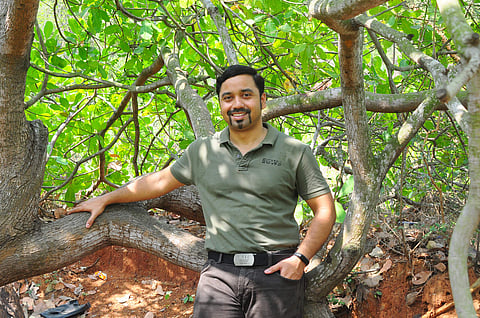

If you were to call Indira Gandhi Zoological Park in Visakhapatnam was Murthy Kantimahanti's second home, he wouldn't disagree. As a 13-year-old volunteer, apart from other work, he used to spend hours there as his uncle brought out friendly, non-venomous snakes from their cage and encouraged people to touch them so that they understand that not every snake is out there to bite a human. At an early age, Murthy had gained the understanding that, "Snakes are highly misunderstood creatures and are, sadly, killed at sight," he shares.
It's a jungle out there
After completing his Master's in Zoology from Andhra University, Murthy joined the zoo again, this time as a biologist, documenting the behaviour of animals in captivity and studying them. After being appointed as the Programme Officer at the Centre for Environment Education in Ahmedabad and setting up interpretation centres — points where people can learn about local species — he came back home because he wanted to carry out conservation work in his own backyard, the Eastern Ghats. That's when he founded Eastern Ghats Wildlife Society (EGWS) in 2013 while continuing to work as a wildlife consultant for the Government of Andhra Pradesh.
Global challenge? Accepted!
But if you think this is the best thing to happen in his life, hold on. He was the only Indian to be chosen for the Emerging Wildlife Leaders Programme in Florida, which is a project supported by a bunch of prestigious organisations including Wildlife Conservation Network, World Wildlife Fund and more. This 18-month programme involved multiple visits to the US, several outdoor field trips and lessons on conservation campaigning, evaluating and assessing conservation impacts which really prepped Murthy for what came next. "This is my best credential so far," he confesses gingerly.
Murthy is now focused on conserving the vast biodiversity of the Eastern Ghats, particularly species like the King Cobra and the lesser known Fishing Cats, Jungle Cats, Leopard Cats and Rusty-spotted Cats (one of the smallest cats in the world). "The problem here is when it comes to conservation, we still stick to the old school approach. There is research and analysis that is done on paper, which we need, but more than this, we need ground action. Also, tigers are not the only animals who need to be conserved, there are several others who are also important to the ecosystem," says the Simhachalam-born conservationist who was brought up in Srikakulam.
He also works with communities, making them aware of why they should care for neglected species. Displaying educational videos, training a local who is available to help catch stray snakes and release them into the wildlife, even distributing footwear as a precaution against being bitten by snakes, there is a lot that the 33-year-old and the volunteers are already doing.
A whole new world
Murthy, simultaneously, also works on interpretation centres — his latest one being in Vijayanagaram. He has helped set up 24 of them till date, most of which are in Telangana and Andhra Pradesh. The centres have 3D models of local animals and interesting facts about them presented in a way that it is easy for a layman to understand.
EGWS is also trying to gather information about the Indian Pangolin, one of the most trafficked animals in the world. But Murthy's ultimate goal is that he wants to set up a first-ever conservation and education centre where people can not just come and learn or do research, but also protect the wildlife out there.
Murthy was recently invited by Houston Zoo in Texas where he spoke about the value of snakes and living with them. He is particularly grateful to Renee Bumpus, Senior Conservation Director at the Houston Zoo for her guidance and support, the local Forest Department who have been both responsive and encouraging, The Madras Crocodile Bank Trust and Centre for Herpetology, Chennai and several others who have helped him on his journey.
How we can help him in his cause:
- Don't kill snakes and other animals at sight
- Learn scientific facts about animals and how they contribute to the ecosystem. Respect who they are
- Help societies that work for welfare by volunteering
